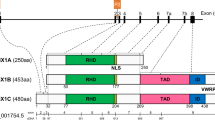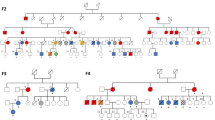Abstract
The RUNX1/AML1 gene is the most frequent target for chromosomal translocation in leukemia. In addition, recent studies have demonstrated point mutations in the RUNX1 gene as another mode of genetic alteration in development of leukemia. Monoallelic germline mutations in RUNX1 result in familial platelet disorder predisposed to acute myelogenous leukemia (FPD/AML). Sporadic point mutations are frequently found in three leukemia entities: AML M0 subtype, MDS-AML, and secondary (therapy-related) MDS/AML. Therapy-related leukemias resulting from anticancer treatments are not uncommon, and the incidence of RUNX1 point mutations appears comparable to the incidence of the t(8;21) AML M2 subtype and the inv(16) AML M4Eo subtype. Half of the point mutations in M0 cases are biallelic, although the frequency varies with ethnicity. Most of the RUNX1 mutations are clustered in the Runt domain and result in defective DNA binding but active β-subunit binding, which is consistent with three-dimensional structural findings and may explain the dominant inhibitory effects. Unlike the classical tumor suppressor genes requiring biallelic inactivation, haploinsufficient RUNX1 is apparently leukemogenic. However, RUNX1 abnormalities per se are insufficient to cause full-blown leukemia. Intensive investigation of cooperating genetic alterations should elucidate leukemic mechanisms.
This is a preview of subscription content, access via your institution
Access options
Subscribe to this journal
Receive 50 print issues and online access
$259.00 per year
only $5.18 per issue
Buy this article
- Purchase on Springer Link
- Instant access to full article PDF
Prices may be subject to local taxes which are calculated during checkout



Similar content being viewed by others
References
Antonarakis SE and Nomenclature Working Group. (1998). Hum. Mutat., 11, 1–3.
Buijs A, Poddighe P, van Wijk R, van Solinge W, Borst E, Verdonck L, Hagenbeek A, Pearson P and Lokhorst H . (2001). Blood, 98, 2856–2858.
Carnicer MJ, Nomdedeu JF, Lasa A, Bellido M, Aventin A, Baiget M and Sierra J . (2002). Leukemia, 16, 2329–2332.
Castilla LH, Wijmenga C, Wang Q, Stacy T, Speck NA, Eckhaus M, Marin-Padilla M, Collins FS, Wynshaw-Boris A and Liu PP . (1996). Cell, 87, 687–696.
Dowton SB, Beardsley D, Jamison D, Blattner S and Li FP . (1985). Blood, 65, 557–563.
Ferrari T, Weber B, Pils S, Harbott J and Borkhardt A . (2001). Ann. Hematol., 80, 72–73.
Gabbeta J, Yang X, Sun L, McLane MA, Niewiarowski S and Rao AK . (1996). Blood, 87, 1368–1876.
Gerrard JM, Israels ED, Bishop AJ, Schroeder ML, Beattie LL, McNicol A, Israels SJ, Walz D, Greenberg AH, Ray M and Israels LG . (1991). Br. J. Haematol., 79, 246–255.
Harada H, Harada Y, Niimi H, Kyo T, Kimura A and Inaba T . (2004). Blood, 103, 2316–2324.
Harada H, Harada Y, Tanaka H, Kimura A and T I . (2003). Blood, 101, 673–680.
Higuchi M, O’Brien D, Kumaravelu P, Lenny N, Yeoh EJ and Downing JR . (2002). Cancer Cell, 1, 63–74.
Huang G, Shigesada K, Ito K, Wee HJ, Yokomizo T and Ito Y . (2001). EMBO J., 20, 723–733.
Ichikawa M, Asai T, Saito T, Yamamoto G, Seo S, Yamazaki I, Yamagata T, Mitani K, Chiba S, Hirai H, Ogawa S and Kurokawa M . (2004). Nat. Med., 10, 299–304.
Imai Y, Kurokawa M, Izutsu K, Hangaishi A, Takeuchi K, Maki K, Ogawa S, Chiba S, Mitani K and Hirai H . (2000). Blood, 96, 3154–3160.
Langabeer SE, Gale RE, Rollinson SJ, Morgan GJ and Linch DC . (2002). Genes Chromosomes Cancer, 34, 24–32.
Li FQ, Person RE, Takemaru K, Williams K, Meade-White K, Ozsahin AH, Gungor T, Moon RT and Horwitz M . (2004). J. Biol. Chem., 279, 2873–2884.
Li J, Shen H, Himmel KI, Dupoy AJ, Lagaespada DA, Nakamura T, Shaughnessy JD Jr, Jenkins NA and Copeland NG . (1999). Nat. Genet., 23, 348–353.
Matsuno N, M O, Yamashita N, Yanagida M, Nanri T, Fukushima T, Motoji T, Kusumoto S, Towatari M, Suzuki R, Naoe T, Nishii K, Shigesada K, Ohno R, Mitsuya H, Ito Y and Asou N . (2003). Leukemia, 17, 2492–2499.
Michaud J, Wu F, Osato M, Cottles GM, Yanagida M, Asou N, Shigesada K, Ito Y, Benson KF, Raskind WH, Rossier C, Antonarakis SE, Israels S, McNicol A, Weiss H, Horwitz M and Scott HS . (2002). Blood, 99, 1364–1372.
Miyoshi H, Shimizu K, Kozu T, Maseki N, Kaneko Y and Ohki M . (1991). Proc. Natl. Acad. Sci. USA, 88, 10431–10434.
Mundlos S, Otto F, Mundlos C, Mulliken JB, Aylsworth AS, Albright S, Lindhout D, Cole WG, Henn W, Knoll JHM, Owen MJ, Mertelsmann R, Zabel BU and Olsen BR . (1997). Cell, 89, 773–779.
Nagata T, Gupta V, Sorce D, Kim W-Y, Sali A, Chait BT, Shigesada K, Ito Y and Werner MH . (1999). Nat. Struct. Biol., 6, 615–619.
Okuda T, van-Deursen J, Hiebert SW, Grosveld G and Downing JR . (1996). Cell, 84, 321–330.
Osato M, Asou N, Abdalla E, Hoshino K, Yamasaki H, Okubo T, Suzushima H, Takatsuki K, Kanno T, Shigesada K and Ito Y . (1999). Blood, 93, 1817–1824.
Osato M, Yanagida M, Shigesada K and Ito Y . (2001). Int. J. Hematol., 74, 245–251.
Preudhomme C, Warot-Loze D, Roumier C, Grardel-Duflos N, Garand R, Lai JL, Dastugue N, Macintyre E, Deni C, Bauters F, Kerckaert JP, Cosson A and Fenaux P . (2000). Blood, 96, 2862–2869.
Rodenhiser DI, Andrews JD, Mancini DN, Jung JH and Singh SM . (1997). Mutat. Res., 373, 185–195.
Roumier C, Eclache V, Imbert M, Davi F, MacIntyre E, Garand R, Talmant P, Lepelley D, Lai JL, Casanovas O, Magnadie M, Mugneret F, Bilhou-Naberra C, Valensi F, Radford I, Mozziconacci MJ, Arnoulet C, Duchayne E, Dastugue N, Comillet P, Daliphard S, Gamache F, Boudjerra N, Jouault H, Fenneteau O, Pedron B, Berger R, Flandrin G, Fenaux P and Preudhomme C . (2003a). Blood, 101, 1277–1283.
Roumier C, Fenaux P, Lafage M, Imbert M, Eclache V and Preudhomme C . (2003b). Leukemia, 17, 9–16.
Silva FP, Morolli B, Storlazzi CT, Anelli L, Wessels H, Bezrookove V, Kluin-Nelemans HC and Micheline G-G . (2003). Oncogene, 22, 538–547.
Song W-J, Sullivan MG, Legare RD, Hutchings S, Tan X, Kufrin D, Ratajczak J, Resende IC, Haworth C, Hock R, Loh M, Felix C, Roy D-C, Busque l, Kurnit D, Willman C, Gewirtz AM, Speck NA, Bushweller JH, Li FP, Gardiner K, Poncz M, Maris JM and Gilliland DG . (1999). Nat. Genet., 23, 166–175.
Sun L, Mao G and Rao AK . (2004). Blood, 103, 948–954.
Tahirov TH, Inoue-Bungo T, Morii H, Fujikawa A, Sasaki M, Kimura K, Shiina M, Sato K, Kumasaka T, Yamamoto M, Ishii S and Ogata K . (2001). Cell, 104, 755–767.
Taketani T, Taki T, Takita J, Ono R, Horikoshi Y, Kaneko Y, Sako M, Hanada R, Hongo T and Hayashi Y . (2002). Leukemia, 16, 1866–1867.
Taketani T, Taki T, Takita J, Tsuchida M, Hanada R, Hongo T, Kaneko T, Manabe A, Ida K and Hayashi Y . (2003). Genes Chromosomes Cancer, 38, 1–7.
Vegesna V, Takeuchi S, Hofmann WK, Ikezoe T, Tavor S, Krug U, Fermin AC, Heaney A, Miller CW and Koeffler HP . (2002). Leuk. Res., 26, 451–457.
Walker LC, Stevens J, Campbell H, Corbett R, Spearing R, Heaton D, Macdonald DH, Morris CM and Ganly P . (2002). Br. J. Haematol., 117, 878–881.
Yergeau DA, Hetherington CJ, Wang Q, Zhang P, Sharpe AH, Binder M, Marin-Padilla M, Tenen DG, Speck NA and Zhang DE . (1997). Nat. Genet., 15, 303–306.
Yoshida T, Kanegane H, Osato M, Yanagida M, Miyawaki T, Ito Y and Shigesada K . (2002). Am. J. Hum. Genet., 71, 724–738.
Yoshida T, Kanegane H, Osato M, Yanagida M, Miyawaki T, Ito Y and Shigesada K . (2003). Blood Cells Mol. Dis., 30, 184–193.
Zhou G, Chen Y, Zhou L, Thirunavukkarasu K, Hecht J, Chitayat D, Gelb BD, Pirinen S, Berry SA, Greenberg CR, Karsenty G and Lee B . (1999). Hum. Mol. Genet., 8, 2311–2316.
Acknowledgements
I thank Drs Hamish S Scott and Hironori Harada for sharing unpublished data. This study was supported by A*STAR (Agency for Science, Technology and Research), Singapore.
Author information
Authors and Affiliations
Corresponding author
Rights and permissions
About this article
Cite this article
Osato, M. Point mutations in the RUNX1/AML1 gene: another actor in RUNX leukemia. Oncogene 23, 4284–4296 (2004). https://doi.org/10.1038/sj.onc.1207779
Published:
Issue Date:
DOI: https://doi.org/10.1038/sj.onc.1207779
Keywords
This article is cited by
-
RUNX1 targeting AKT3 promotes alveolar hypercoagulation and fibrinolytic inhibition in LPS induced ARDS
Respiratory Research (2024)
-
RUNX1 mutation has no prognostic significance in paediatric AML: a retrospective study of the AML-BFM study group
Leukemia (2023)
-
Childhood hematopoietic stem cells constitute the permissive window for RUNX1-ETO leukemogenesis
International Journal of Hematology (2023)
-
Runt-related transcription factors in human carcinogenesis: a friend or foe?
Journal of Cancer Research and Clinical Oncology (2023)
-
Regulome analysis in B-acute lymphoblastic leukemia exposes Core Binding Factor addiction as a therapeutic vulnerability
Nature Communications (2022)



